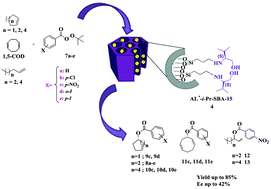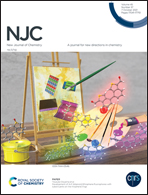Immobilization of (l)-valine and (l)-valinol on SBA-15 nanoporous silica and their application as chiral heterogeneous ligands in the Cu-catalyzed asymmetric allylic oxidation of alkenes†
Abstract
SBA-15 nanoporous silica was synthesized by hydrothermal method using P123 surfactant and tetraethoxyortosilicate in acidic condition and then functionalized by 3-chloropropyltrimethoxysilane. Next, by immobilization of chiral amino acid (S)-2-amino-3-methyl butanoic acid (L-valine) and chiral amino alcohol (S)-2-amino-3-methylbutane-1-ol (L-valinol), prepared via the reduction of L-valine by NaBH4/I2 in THF, on functionalized-SBA-15, chiral heterogeneous ligands AL*-i-Pr-SBA-15 and AA*-i-Pr-SBA-15 were prepared and characterized by FT-IR, XRD, TGA, EDX, SEM, BET-BJH techniques. The asymmetric allylic oxidation of alkenes was done using copper-complexes of these ligands and the as-synthesized peresters. The reactions were optimized by varying various parameters such as temperature, solvent, amount of chiral heterogeneous ligand, as well as the type and amount of copper salt. Under optimized conditions, 6 mg of AL*-i-Pr-SBA-15 and 3.2 mol% of Cu(CH3CN)4PF6 in acetonitrile at 50 °C, the chiral allylic ester was obtained with 80% yield and 39% enantiomeric excess in 24 h. The recyclability of the chiral heterogeneous catalysts was also evaluated without significant reduction in the reaction results up to three runs.



 Please wait while we load your content...
Please wait while we load your content...